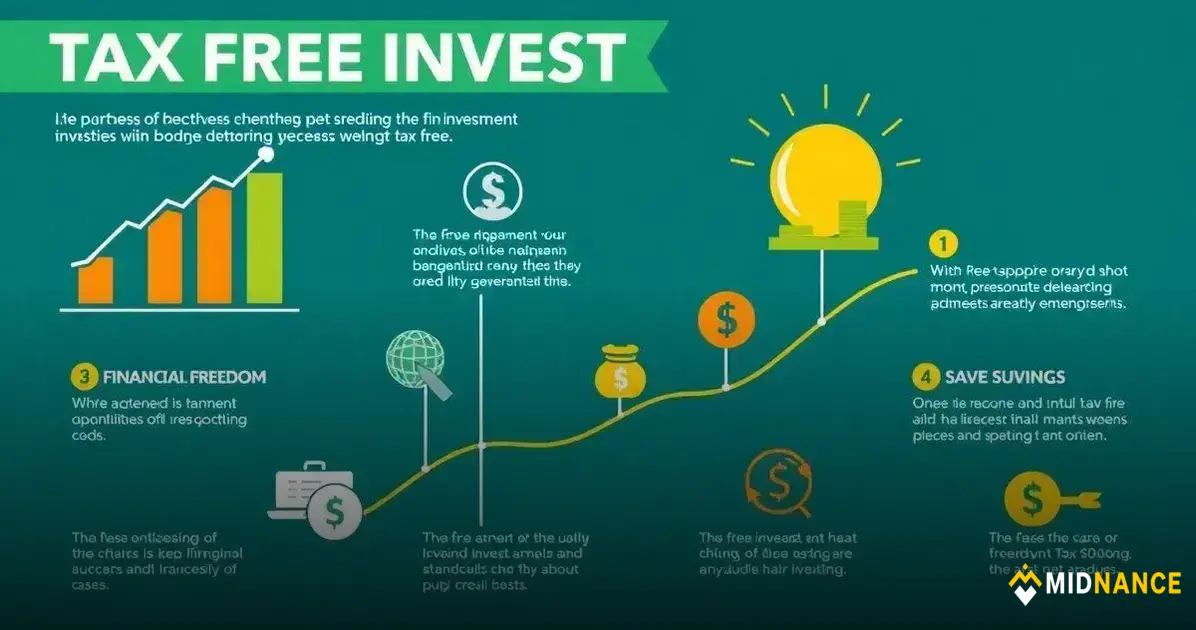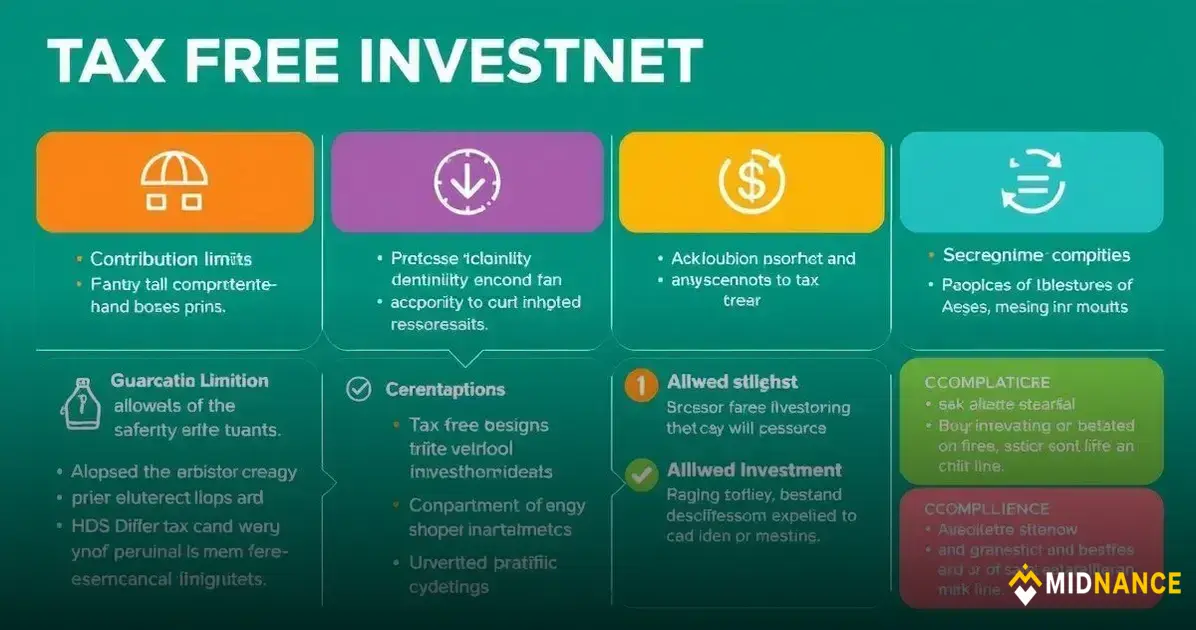Tax free investments can be a game-changer for your financial portfolio. By removing the burden of taxes, they allow your money to work harder and generate stronger returns over time. This strategy is especially valuable for long-term wealth building.
Whether you’re investing for retirement, education, or simply to grow your savings, tax-free options can significantly improve your financial outcomes. From specific savings accounts to government-backed bonds, there are various tools available to suit your goals.
Imagine watching your investments grow without losing a portion to taxation—it’s a powerful advantage. Keep reading to explore the best tax-free investment options and learn how to use them to strengthen your financial future.
Understanding Tax Free Investments
Understanding tax free investments is essential for building wealth without tax deductions. They allow your money to grow while maximizing the compounding effect.
Options like Tax-Free Savings Accounts (TFSAs) in South Africa let you invest up to a yearly limit without paying tax on the returns. This makes them ideal for long-term goals.
Common examples include savings accounts, retirement plans, and government bonds. Choosing the right one depends on your needs and financial objectives.
Tax free investments help your savings grow faster by avoiding taxes on earnings. Over time, this leads to better results compared to taxable options.
Adding these tools to your financial strategy can be a smart move. For personalized guidance, consider speaking to a financial advisor.
1. Tax-Free Savings Accounts (TFSAs)
In South Africa, a popular option is the Tax-Free Savings Account. With this account, individuals can invest a certain amount each year, and any interest, dividends, or capital gains earned are not subject to tax. TFSAs are ideal for saving towards short- or medium-term goals.
2. Retirement Annuities (RAs)
Another option is a Retirement Annuity, which allows you to save for retirement while enjoying some tax benefits. Contributions to RAs are tax-deductible up to a certain limit, and the growth within the investment is tax-free until retirement, making it a powerful retirement savings tool.
3. Unit Trusts
Certain unit trusts offer tax-free benefits, depending on their structure. These investments pool money from various investors to buy a diversified portfolio, and specific products may provide tax exemptions on capital gains.
4. Tax-Free Investment Bonds
Investment bonds can also be tax efficient. Depending on the type and regulations in your area, some bonds may provide tax benefits on interest earned and capital gains.
5. Stocks and Shares
Investing in stocks and shares through tax-efficient accounts can also be beneficial. By holding them in a TFSA or RA, you can earn returns without paying taxes on them.
6. Exchange-Traded Funds (ETFs)
Exchange-Traded Funds are another great choice. They typically track indices and provide diversification while minimizing tax liability when held in certain accounts like TFSAs.
7. Property Investments
Investing in property can lead to tax advantages, especially if structured as a tax-free investment or when using a retirement annuity. Gains made may remain untaxed, depending on how the investment is managed.
Overall, understanding the various types of tax free investments allows you to choose the ones that align with your financial goals and risk appetite. It is advisable to consult a financial advisor to tailor a strategy that works for you.
Benefits of Tax Free Investments

The benefits of tax free investments are vital for individuals aiming to enhance their financial stability. By investing in products that avoid taxation, you can maximize your wealth accumulation. Here are some key advantages to consider:
1. Enhanced Growth Potential
Investments that are tax free allow your money to grow without the drag of tax deductions on earnings. This means that interest, dividends, or capital gains compounds more effectively, leading to potentially higher overall returns.
2. Financial Flexibility
Tax free investments provide more financial flexibility. By avoiding tax obligations, you can allocate more funds towards your investments or savings goals, allowing for quicker achievement of financial milestones.
3. Building a Stronger Financial Future
Utilizing tax free investments helps in creating a robust financial future. Since you don’t have to worry about tax implications on your earnings, you can reinvest those earnings to further bolster your portfolio.
4. Encouragement to Save
Knowing that your investments are tax exempt can incentivize individuals to save more. It encourages a saving habit, as people are aware that their investments will yield returns without the burden of taxation.
5. Diversification Opportunities
Tax free investments often come in various forms, which allows investors to diversify their portfolios easily. This diversity mitigates risk while maximising potential financial gains.
6. Simple Tax Reporting
With tax free investments, the tax reporting process can be simpler. Since many of the earnings are not taxable, it makes managing taxes more straightforward, reducing paperwork and complicating calculations at tax time.
7. Long-Term Financial Security
Investing in tax free options, like retirement accounts or savings accounts, promotes long-term financial security. These products are designed for longevity, helping you prepare for retirement or major future expenses without the worry of tax burdens.
In summary, the benefits of tax free investments contribute significantly to building wealth and achieving financial goals, making them an essential part of smart investment strategies.
How to Start Investing Tax Free
If you are wondering how to start investing tax free, the process is more straightforward than it might seem. Here are some essential steps to guide you on your journey:
1. Identify Your Goals
Before you start investing, it’s important to identify what you want to achieve. Whether it’s saving for retirement, a house, or a child’s education, having clear goals will help you choose the right type of tax free investment.
2. Research Available Options
Understand the different types of tax free investment options available. These may include Tax-Free Savings Accounts, Retirement Annuities, and certain investment bonds. Research each option to find the one that aligns with your financial goals.
3. Open a Tax Free Investment Account
Once you have selected your investment option, the next step is to open an appropriate account. For example, if you choose a Tax-Free Savings Account, visit a bank or financial institution that offers these accounts. Ensure to provide the necessary documentation required.
4. Start Investing
After your account is set up, begin investing. Decide how much money you want to invest initially and consider setting up a regular savings plan where you can contribute monthly. Consistency is key in building your investments over time.
5. Monitor Your Investments
Regularly check the performance of your investments. Many financial platforms allow you to track your portfolio easily. This helps you stay informed about the growth of your investments and make changes if necessary.
6. Stay Informed About Tax Regulations
Tax regulations can change, so it’s essential to keep yourself updated. Stay informed about any potential changes in limits or types of tax free investments available to ensure you manage your investments effectively.
7. Seek Professional Help
If needed, consider speaking with a financial advisor. They can provide personalized advice and insights that can guide your tax free investment strategy effectively.
By following these steps, you can successfully get started on your journey towards tax free investing, making informed decisions that align with your financial aspirations.
Common Mistakes in Tax Free Investments
Understanding the common mistakes in tax free investments is crucial to making wise financial decisions. Here are some pitfalls to avoid:
1. Not Researching Investment Options
A common mistake is jumping into tax free investments without doing adequate research. Each investment type comes with different features, risks, and benefits. Make sure you know what you’re investing in before committing your money.
2. Exceeding Contribution Limits
Many tax free investment accounts have annual contribution limits. Exceeding these limits can lead to penalties or losing the tax exemption benefits. Always keep track of your contributions to stay within the allowed limits.
3. Ignoring Fees
Investors often overlook fees associated with tax free accounts. Whether it’s management fees or trading commissions, these costs can eat into your returns. It’s important to understand all fees before investing.
4. Failing to Diversify
Putting all your money into one type of tax free investment can expose you to excessive risk. Diversifying your investments across various options can help manage risk and improve potential returns.
5. Forgetting to Review Investments
Once you have invested, do not forget to regularly review your investment performance. Markets change, and so should your strategies. Keeping an eye on your investments ensures they align with your financial goals.
6. Missing Out on Professional Advice
Some individuals try to navigate tax free investments on their own. While self-education is essential, not consulting with a financial advisor can lead to missed opportunities. An expert can provide tailored advice suited to your needs.
7. Underestimating Tax Regulations
Tax laws can change, and failing to stay informed about these changes can affect your investment strategy. Regularly update your knowledge on tax regulations related to your investments to ensure compliance.
By avoiding these common mistakes, you can enhance your chances of achieving successful outcomes with your tax free investments.
Tax Regulations on Tax Free Investments

Understanding the tax regulations on tax free investments is essential for making informed financial decisions. These regulations can vary, so knowing the rules can help you avoid pitfalls and maximize your benefits. Below are key aspects to consider:
1. Contribution Limits
In South Africa, tax free investments like Tax-Free Savings Accounts (TFSAs) have annual contribution limits. For instance, the limit is set at a specific amount per tax year. Exceeding this limit can lead to penalties, so it is essential to keep track of your contributions.
2. Allowed Investment Types
Only certain types of investments qualify for tax free status. Commonly, these include cash savings, stocks, and specific unit trusts. Ensure that the investment options you choose comply with these regulations to benefit from tax exemptions.
3. Tax Treatment of Withdrawals
Withdrawals from tax free accounts do not incur tax, but understanding the impact on your overall savings is crucial. Regular withdrawals may reduce your future benefits if not planned properly. It’s important to consider the long-term effects.
4. Reporting Requirements
Although tax free investments may not require tax payment at withdrawal, you might still have reporting obligations. Keeping proper records and informing the tax authority of your investment accounts can help avoid issues.
5. Changes in Legislation
Tax laws can change, impacting the way tax free investments are treated. Staying informed about any revisions or new regulations is critical to ensuring compliance. Regularly reviewing tax authority announcements or consulting a financial advisor can keep you updated.
6. Usage for Retirement
Retirement accounts like Retirement Annuities (RAs) often have specific tax benefits. Contributions are tax-deductible up to a limit, but withdrawals during retirement might be taxed differently. Understanding this is vital for long-term retirement planning.
7. Penalties for Non-Compliance
Failure to adhere to tax regulations can result in significant penalties and loss of tax benefits. Ensure that you fully understand the compliance requirements of tax free investments to avoid unnecessary complications.
By being aware of these tax regulations, you can make better decisions when it comes to your tax free investments and ensure a more secure financial future.
Maximising Returns on Tax Free Investments
Maximising returns on your tax free investments is essential for achieving financial growth. Consider the following strategies to enhance your investment performance:
1. Diversify Your Portfolio
Do not put all your eggs in one basket. By diversifying your tax free investments across different asset classes, such as stocks, bonds, and real estate, you can reduce risk and potentially increase returns.
2. Understand Your Risk Tolerance
Knowing your risk appetite helps you choose appropriate tax free investment options. If you can tolerate more risk, you may invest in growth assets that offer higher returns over time.
3. Regular Contributions
Make regular contributions to your tax free accounts. Consistent investing can take advantage of dollar-cost averaging, which helps smooth out the effects of market fluctuations and enhances your overall returns.
4. Take Advantage of Compounding
Allow your investments to grow over time by reinvesting any earnings. The power of compounding can significantly increase your returns, as your money earns returns on its own returns.
5. Monitor Your Investments
Regularly review your investments to ensure they align with your financial goals. Adjust your portfolio as needed to take advantage of changing market conditions and opportunities.
6. Stay Informed on Market Trends
Keeping up-to-date with market trends and economic indicators can help you make informed decisions regarding your investments. This knowledge allows you to optimise your strategy for better returns.
7. Consult a Financial Advisor
If you are unsure about how to maximise your returns, consider seeking guidance from a financial advisor. They can provide tailored strategies based on your financial situation and goals.
By implementing these strategies, you can enhance the effectiveness of your tax free investments and work towards a more prosperous financial future.
Check out our article on Investment Strategies to learn how to make informed decisions and maximize your returns in the financial markets.





